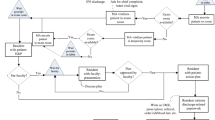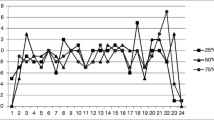Abstract
Outpatient services are increasingly recognised as an important component of health care provision and may be improved through the application of modern management techniques. We have performed a time and role audit of consultation and waiting times in two medical clinics using different queuing systems: namely, a serial processing clinic where patients wait in a single queue and a quasi-parallel processing clinic where patients are directed to the shortest queue to maintain clinic flow. Data collected were used to construct a computer simulation of patient flows in clinic. Assessment of patient satisfaction in the clinic process was determined using a self-administered questionnaire. Mean waiting time was shorter in the quasi-parallel processing clinic: 26 (SD 17) minutes compared with 36(24) minutes in the serial processing clinic. In the serial processing clinic 61% of patients waited more than 30 minutes compared with 41% in the quasi-parallel processing clinic. In the serial processing clinic 8% of 142 patients surveyed complained of the time spent waiting. The computer simulation we produced was able to determine waiting times with different clinic structures. The simulation showed that reductions in waiting time up to 30% might be achieved by changing our serial processing clinic to a quasi-parallel processing one. Performance of medical outpatient clinics can be improved by examining and changing clinic management. Computer simulation of outpatient clinics offers a means of assessing the impact of such changes on waiting time in clinic and on waiting lists.
Similar content being viewed by others
References
Department of Health (1989).Health and Personal Social Statistics for England and Wales for 1988, Department of Health, London.
Secretaries of State for Heahth, Wales, Northern Ireland and Scotland (1989).Working for Patients, HMSO, London.
Hopkins, A. and Costain, D. (eds.) (1990).Measuring the Outcome of Medical Care, Royal College of Physicians and King's Fund Centre, London.
The Patient's Charter (1991). HMSO, London.
Bopp, K. D. (1990). How patients evaluate the quality of ambulatory medical encounters: a marketing perspective.Journal of Health Care Medicine 10, 6–15.
McIvor, S. (1990).Obtaining the Views of Outpatients, King's Fund Centre, London.
Morrell, D. C., Evans, M. E., Morris, R. W.et al. (1986). The five minute consultation: effects of time constraint on clinical contact and patient satisfaction.British Medical Journal 292, 870–873.
Roland, M. O., Bartholomew, J. and Courtenay, M. J. F. (1986). The ‘five minute’ consultation: effect of time constraint on verbal communication.British Medical Journal 292, 874–876.
Armstrong, D. (1991). What do patients want?British Medical Journal 303, 261–262.
George, S., Read, S., Westlake, L.et al. (1992). Evaluation of nurse triage in a British accident and emergency department.British Medical Journal 304, 876–878.
Worthington, D. J. (1987). Queuing models for hospital waiting lists.Journal of Operational Research Society 38, 413–422.
Author information
Authors and Affiliations
Rights and permissions
About this article
Cite this article
Edwards, R.H.T., Clague, J.E., Barlow, J. et al. Pragmatics. Health Care Anal 2, 164–169 (1994). https://doi.org/10.1007/BF02249741
Issue Date:
DOI: https://doi.org/10.1007/BF02249741




